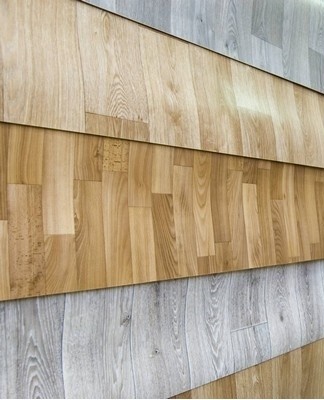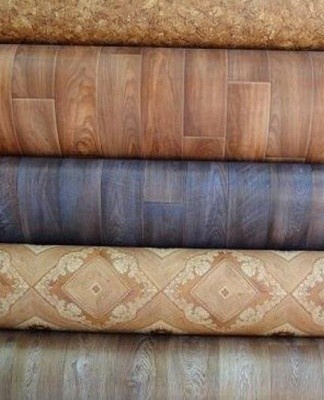Which linoleum is better to choose for the kitchen depending on the type of material, texture and color
One of the most practical and inexpensive materials for flooring is linoleum. It has good technical characteristics, long service life and a huge selection of colors. Designers appreciated the interesting textures of roll products and are widely used in the decoration of rooms. In order to decorate a room in a practical and tasteful way, you need to know what linoleum to choose for the kitchen and how to lay the finishing layer.
Basic Kitchen Requirements
The room is characterized by high traffic, temperature and humidity changes. Therefore, floors should have high wear resistance, water-repellent properties and be easy to clean. Main requirements:
- optimal thickness - from 3 mm;
- material resistance;
- correspondence of the size of the canvas to the dimensions of the kitchen;
- type of product - PVC-based household or semi-commercial;
- good workmanship and finishes.
The design should harmoniously complement the furniture in the room, and not "argue" with the basic colors of the interior.
Varieties
To choose the right flooring, you need to know what types of linoleum are and whether they can all be used in the kitchen. The range of manufactured materials is quite large and diverse, therefore it is necessary to rely on the main characteristics of the products.
Natural
For production, linseed oil, finely ground lime, cork bark, shell powder, pine resin and natural dyes are used. The base is natural jute or non-woven fabric. Advantages: respect for the environment, shape and color retention, ease of maintenance, resistance to UV rays. Disadvantages: fragility when folding, poor water-repellent properties, high cost.
Attention! Before buying, you need to carefully check the natural product - during transportation, cracks may form in bends.
Polyvinyl chloride
For the manufacture of synthetic linoleum, a jute base, expanded polyvinyl chloride, polyester or velor are used. A special composition is applied on top, obtained by mixing plasticizers that give elasticity, cork flour, acrylates, mineral additives, stabilizers, pigments. PVC has gained great popularity due to its good quality and affordable price. Advantages: high resistance to humidity, easy to clean, easy to install. Disadvantages: temperature sensitivity, poor resistance to chemicals.
On a note! In low temperature conditions, the elasticity of the synthetic product decreases and cracks appear. Therefore, in winter, it is recommended to choose the material in a warm store, and not in the market.
Rubber
Rubber linoleum is called relin.In its production, bitumen, recycled rubber, synthetic rubber, pigments and filler additives are used as the basis. The material cannot be called environmentally friendly due to the release of toxic substances. The advantages of Relin include high elasticity and moisture resistance, but it is forbidden to lay it in living quarters.

Glyphthal
The second name of such linoleum is alkyd. The material contains alkyd resins. The advantages of glyphtal linoleum include good heat and sound insulation. But a serious drawback is the fragility and complexity of the installation.
Important! Before laying, the alkyd material should be kept in a warm room so that it does not deform after laying.
Colloxylin
Plasticizers, fillers and pigments are added to the composition obtained from the nitration of wood or cotton cellulose. The result is a baseless canvas with a smooth finish. The advantages of colloxyline products are moisture resistance and fire safety. But there are also disadvantages - susceptibility to temperature changes and shrinkage.
Forms of material release
As standard, linoleum is produced in rolls with a width of 1-1.5 to 4-6 m. But to simplify the installation process, manufacturers offer other types of materials:
- Square tiles imitate parquet. Due to their small size, they can be laid in different directions, to reproduce diagonal and geometric patterns.
- Long slats of linoleum look like laminate. The material is convenient to install, it is easy to lay it even by yourself. If necessary, you can easily disassemble and replace the worn part.
- Liquid linoleum made of epoxy and polyurethane resins is laid in the form of a seamless monolithic floor. It has good waterproofing, does not deteriorate with frequent cleaning and exposure to household products.
When laying tiled linoleum, a lot of seams are formed, so the material no less tolerates frequent washing, and the advantage of a liquid coating is a perfectly flat surface and the ability to change the design without dismantling .

Appearance options
Linoleum with a matte or glossy topcoat looks equally impressive in the kitchen space. It is easier to clean a smooth surface, in the pores of which dirt practically does not clog. Basic colors for the kitchen:
- beige and brown palette with imitation of natural wood;
- rich shades of pearl-gray to match the color of stone or ceramic;
- mosaic patterns that fit perfectly into any interior;
- fancy textures and patterns for an original decor;
- linoleum imitating parquet or laminate.
In the design of the kitchen linoleum looks beautiful with the texture of wood species - beech, cherry, rosewood, oak. Abstract and geometric patterns add a special charm to the room. Floors "under the stone" - marble or granite, remain relevant.
Important! When decorating a kitchen floor, it is impractical to use light linoleum - it quickly gets dirty and requires constant maintenance.
Wear classification
According to the European standard EN685, linoleum is divided into groups according to the level of wear resistance. The indicator is formed by two digits - the first indicates the type of room in which the material can be laid, and the second indicates the degree of maximum permissible load on the floor.
Table 1. Basic Features
| Wear resistance level | Abrasion grade and group | |||||
| Residential | Companies. | Industry. | The lowest | moo | Mean | The most stable. |
| 21-23 | 31-34 | 41-43 | Heavily abraded. F (up to 0.6mm) | Moderately abraded. M (0.3mm) | Weakly abraded. P (0.15mm) | The strongest T (0.08 mm) |
According to the European certificate EN660-1, the most important characteristic of linoleum is the abrasion class. It is defined as an indicator of the degree of wear of the upper protective layer when exposed to an abrasive.
Based on the parameters of resistance to abrasion and wear, linoleum is classified into household, semi-commercial and commercial.In order for the material to serve in the kitchen for a long time, it is recommended to choose a coating of at least least 23 classes, but the best solution is 32-33 classes.

Thickness
Homogeneous products consist of a single layer. The thickness of linoleum does not exceed 3 mm, so the material is not in great demand. Multi-layer (heterogeneous) coating is a composition of several materials with a solid base, intermediate layers, decorative finishes and a protective layer. The thickness varies from 3 to 6 mm.
Household linoleum has a protective thickness of 0.2-0.25 mm, semi-commercial - 0.4-0.6 mm, commercial - 0.6-0.8 mm. The middle option is suitable for the kitchen. With the same "pedestrian" load, the material will last at least 5-7 years. The most important value is not the thickness of the linoleum, but the height of the transparency, which should be optimally 0.5 mm.
Manufacturers
Many companies are engaged in the manufacture of linoleum. Among them, several world-renowned manufacturers whose products are of impeccable quality:
- Forbo (UK);
- SOMMER (France);
- TARKETT (Germany);
- IVC (Belgium);
- ARMSTRONG (UK).
Products of the domestic brand Sinteros (Russia) are no less popular with consumers. Linoleum from these manufacturers has such advantages as durability, strength, environmental friendliness and a wide range of colors and textures.
How to choose the right one
Before buying linoleum, you need to measure the floor - the greatest width and length. The dimensions of niches and doors are determined separately. To each obtained value, add 80 mm - this is a margin for irregularities and protrusions along the perimeter of the floor.
How to choose the right linoleum:
- There should be no oily (greasy) shine on the surface, and high-quality products do not have a specific smell.
- The product should consist of 5 layers with a total thickness of 3 mm. The pattern should be clear, without streaks or spots.
- It is recommended to choose linoleum corresponding to the dimensions of the room, with a small allowance for trimming.
- It is necessary to familiarize yourself with the technical documentation to check the declared wear resistance class.
- When evaluating the quality, you should pay attention to the condition of the surface. The presence of cracks, ripples, bumps, areas with an exfoliated film is not allowed.

The consumer independently determines the color, texture and effect of the decorative coating, proceeding from his own taste preferences. But the colors and patterns should be in harmony with the general interior of the kitchen.
On a note! In a bedroom with a bright suite, dark floors look beautiful. If the furniture is dominated by bright colors, choose a neutral color upholstery. A beautiful pattern will help emphasize the calm atmosphere.
Surface preparation
It is necessary to lay the linoleum after the preparatory work. The service life of the material depends on the correctness of its implementation.Also, in order to perfectly lay the floor decor, you must first level the base.
Remove the old coating
Linoleum can be installed over an existing floor if it is firmly anchored to the subfloor. Otherwise, the old coating must be removed. If the kitchen has a plank floor and the condition of the wood is good, you can mount plywood sheets on it. They are simply screwed with self-tapping screws. It is also allowed to lay linoleum on the tiles if the coating is monolithic. If the fragments have peeled off or do not adhere well, the old material is dismantled and a concrete base is prepared.
Surface leveling
The surface must be clean, dry, perfectly flat and smooth, free of dirt, oil stains or paint residue. Before installing linoleum strips, it is recommended to add an intermediate layer of cork, plastic, plywood. It is necessary to eliminate irregularities, seal cracks and chips with putty, cement or resin.The ideal option is to level the floor with a self-leveling cement mixture. After complete drying, the surface is carefully sanded.
Cleaning
It is recommended to vacuum the prepared base before laying the linoleum. It is important that the floor under the linoleum is dry, otherwise the decorative coating will swell. A damp substrate can cause an unpleasant musty smell in the kitchen.
Padding
Coating a wood or concrete substrate with a primer helps prevent mold growth and improves the bond (adhesion) to the adhesive. The primer must dry at least as specified by the manufacturer (from 24 hours).

How to fit properly
After preparing the base, the rolled roll is brought into the room and left for 1-2 days.After leveling the material, it is cut and the installation of the canvas is started:
- Without glue: double-sided adhesive tape is attached around the edge of the sheet and at the base. Linoleum is laid, leveled and passed with a wooden spatula to remove air bubbles from under the sheet.
- With glue: fold the canvas (but don't fold it!) In the middle, apply the glue with a notched trowel. Before applying the material to the floor, let it sit for 1-2 minutes for the glue to show its properties. After laying, drive out the air with a smooth spatula, glue the second part of the canvas.
- Glue putty: the method is expensive and time-consuming, so it is rarely used at home.
When trimming linoleum, it is necessary to leave a technological gap between the coating and the wall of 5 mm for the free movement of the canvas when shrinking.
Common Mistakes
Some consumers make mistakes when choosing and installing the material, which ultimately leads to the formation of a poor-quality and short-lived coating. The most common errors are:
- styling immediately after delivery - the material does not have time to level out;
- ignore surface preparation - as a result, the canvases bristle;
- storage of the roll in a horizontal position - waves are formed;
- installation on dirty, wet floors - the canvas does not stick, over time a fungus appears;
- cutting material without a gap - the waves remain.
For thin sheets of linoleum, a high-quality flat base is required. Otherwise, any defect or imperfection will be visible.
Tips and tricks from experienced craftsmen
It is advisable to buy linoleum in a store, from a batch, so that there are no color differences.Before buying linoleum, you need to know the exact dimensions of the room and choose a sheet of the corresponding dimensions plus 80 mm of stock. Other tips:
- Folding a long roll in half is not recommended.
- Do not stick adhesive tape on the front side of the canvas.
- Linoleum should be bent inward. If it is bent the other way, you need to wrap the roll with a protective film.
- To securely fix the canvas, it is better to lay it on glue.
- If there are seams, the joints must be carefully glued.
Linoleum serves as a beautiful decoration for a room. It is inexpensive compared to other coatings, long lasting and has moisture resistant properties. To get a high-quality coating, you need to choose the right linoleum and follow the installation rules.



